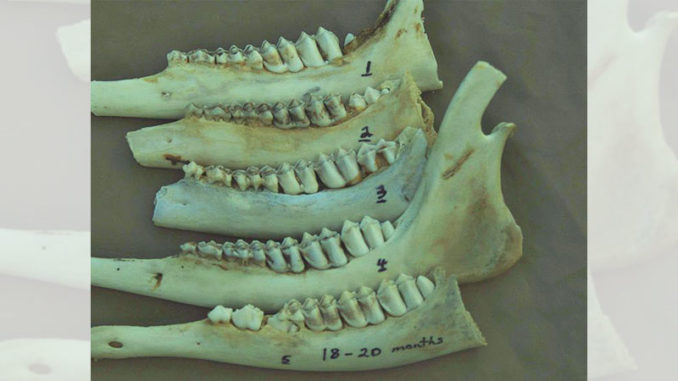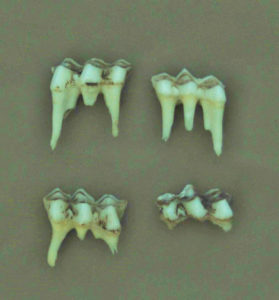
The year-and-a-half age class
The key to aging yearling deer — deer that are 1 year old— is the third premolar. The third premolar is a temporary tooth that has three cusps (or crests.) Both fawns and yearling deer have this temporary three-cusped premolar.
As discussed in last month’s column, fawns will only have one molar erupted. As the fawn grows older, the second molar begins to erupt, followed by the eruption of the third molar. So, the difference between a fawn and a yearling deer is the addition of the second and third molars to the lower jaw.
As the yearling deer approaches the 2-year age class, these temporary premolars are replaced with permanent premolars, with the third premolar now having two cusps. This two-cusped premolar is now the key for separating the yearling deer from 2-year-old (adult) deer. This will be discussed more in the next issue when we look at the young adult age classes.
It was also discussed last month that because during hunting season deer are at the halfway mark for the year, they are aged as 1 ½, 2 ½, 3 ½, etc.
Deer that breed early in October and November have fawns born in May and June — so the half-year increment fit well for aging purposes. These early-breeding deer are found in Areas 2, 3, 7, 8 and 10.

But late-breeding areas, like 1, 4, 5, 6 and 9, can be a little challenging since the fawns are born late — and tooth eruption is behind early-born deer. However, the third temporary premolar with the three cusps is the key, even though they may not have the full complement of molars in the lower jaw.
The typical early-born yearling deer jawbone (as found in Area 2 deer) will have the three temporary premolars, with three molars that are fully erupted in November and December. As these deer grow older, the temporary premolars may begin to break apart and be replaced with permanent premolars in January. This generally occurs around Month 18.
The typical late-born yearling jawbone (as found in Area 6) will have the three temporary premolars, with only two molars fully erupted in November and even December. As this deer grows older, the third molar will begin to erupt — and by January will look like the Area 2 jawbone in November, with the three temporary premolars and three molars fully erupted. Generally, these deer do not begin to shed their temporary premolars until after hunting season, although those fawns born in late-July or August may begin losing these premolars in January.
These yearling deer are basically adult deer; yearling does should breed and produce their first fawn, and yearling bucks grow their first set of antlers. This is the age class of bucks that most hunters pass up with hopes that their antlers will grow larger over time. For best antler development, a yearling buck should weigh at least 120 pounds or more. Yearling bucks that weigh 100 pounds or less are generally small spikes, and unless there is quality nutrition on the landscape, they will not catch up to those deer that weigh 120 or better. If the yearling doe body weights are low, they may not be successful breeders and may not produce a fawn at age 2.
There is no reason at all for hunters not to be able to recognize deer that are 6 months old (fawns) and deer that are 1 1/2 years old (yearlings.)
Once again the key is that third temporary premolar with three cusps or crests. Fawns will only have one molar, and yearlings will have two or three molars.
In the typical deer herd, these two age classes represent two-thirds of the herd, but are the two age classes that are often passed up by hunters. Keep in mind that if you are trying to manage and monitor the growth and development of your deer herd, some deer from these two age classes should be harvested in an effort to understand growth trends and identify potential problems.
Turkey hunting in May
For those of you who did not kill a turkey in April, maybe you connected in May since the season ran through the 6th in Area A. This was a historic season, since the spring squirrel season opened on May 5. Some states have fall turkey seasons that are open during squirrel season. If you killed a turkey this past season, consider yourself blessed. If you killed one in May during spring squirrel season, it was a double-blessing if you hunted the bushytails, also. Many hunters found turkey hunting in 2018 to be tough and unsuccessful. Because of the low turkey numbers on and around our property, the 2018 season was a bust — just like 2016 and 2017. To have success turkey hunting, one has to go to areas that have good turkey populations, which currently seem few and far in this state. To have a good turkey population an area has to have a lot of turkeys. And to have a lot of turkeys, you have to have a lot of turkeys. That sounds like a bunch of double talk, but when you have a bird that nests on the ground, production can be hit or miss. When numbers decline, it really can get bad with all the factors working against this ground-nesting bird, like weather, predators, floods, etc. This is why turkey populations can be cyclic, and a low population may remain low for many years.
Sometimes it may not recover unless a booster release is made to try to get the population up and going again. I am hoping that in the years I have remaining on this earth as we know it, the turkey population will rebound and not go the way of the Bobwhite Quail. It is a basic fact that Louisiana does not have the turkey population that hunters in this state desire. This is one reason so many Louisiana hunters go out of state to turkey hunt. I am also hoping this new season structure will produce results, otherwise I may have to become an out-of state-hunter, too.


